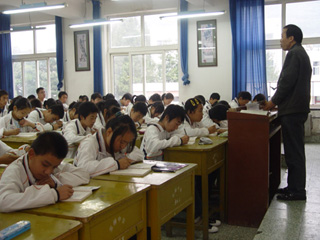
 China Tours
China Tours Tibet Tours
Tibet Tours China Theme Tours
China Theme Tours Off The Beaten Track
Off The Beaten Track Yangtze Cruises
Yangtze Cruises China Trip Planner
China Trip Planner Travel Agents
Travel Agents


We had a wonderful time in Tibet. We have learned a lot about this unique destination because of the wonderful guide Degyi who is so knowledge and always available towards our tours. We stayed at the Shangri-La Hotel Lhasa, and we would never imagine a Tibet travel could be so nice and amazing without the help of Degyi.
Also, thanks a lot to our Tibetan driver Mr.Wongdun for his safe driving and a good sense of service along the way.
We shall return Tibet in the near future!
P.B. and A. A - Europe
Tibet Travel
June 2018 (Private Tibet Journey from Kathmandu)

 Since 1950 China has provided nine-year compulsory education for a fifth of the world's population. Nine-year compulsory education operates in 90 percent of China's populated areas, and illiteracy in the young and mid-aged population has fallen from over 80 percent down to five percent. The system trained some 60 million mid- or high-level professionals and near 400 million laborers to junior or senior high school level. Today, 250 million Chinese get three levels of school education, (elementary, junior and senior high school) doubling the rate of increase in the rest of the world during the same period. Net elementary school enrolment has reached 98.9 percent, and the gross enrollment rate in junior high schools 94.1 percent.
Since 1950 China has provided nine-year compulsory education for a fifth of the world's population. Nine-year compulsory education operates in 90 percent of China's populated areas, and illiteracy in the young and mid-aged population has fallen from over 80 percent down to five percent. The system trained some 60 million mid- or high-level professionals and near 400 million laborers to junior or senior high school level. Today, 250 million Chinese get three levels of school education, (elementary, junior and senior high school) doubling the rate of increase in the rest of the world during the same period. Net elementary school enrolment has reached 98.9 percent, and the gross enrollment rate in junior high schools 94.1 percent.China's educational horizons are expanding. Ten years ago the MBA was virtually unknown but by 2004 there were 47,000 MBAs, trained at 62 MBA schools. Many people also apply for international professional qualifications, such as EMBA and MPA; close to 10,000 MPA students are enrolled in 47 schools of higher learning, including Peking University and Tsinghua University. The education market has rocketed, with training and testing for professional qualifications, such as computer and foreign languages, thriving. Continuing education is the trend, once in one's life schooling has become lifelong learning.
International cooperation and education exchanges increase every year. China has more students studying abroad than any other country; since 1979, there have been 697,000 Chinese students studying in 103 countries and regions, of whom 185,000 have returned after finishing their studies. The number of foreign students studying in China has also increased rapidly; in 2004, over 110,000 students from 178 countries were studying at China's universities.
Investment in education has increased in recent years; the proportion of the overall budget allocated to education has been increased by one percentage point every year since 1998. According to a Ministry of Education program, the government will set up an educational finance system in line with the public finance system, strengthen the responsibility of governments at all levels in educational investment, and ensure that their financial allocation for educational expenditure grows faster than their regular revenue. The program also set out the government's aim that educational investment should account for four percent of GDP in a relatively short period of time.
For non-compulsory education, China adopts a shared-cost mechanism, charging tuition at a certain percentage of the cost. Meanwhile, to ensure that students from low-income families have access to higher education, the government has initiated effective ways of assistance, with policies and measures as scholarships, work-study programs, subsidies for students with special economic difficulties, tuition reduction or exemption and state stipends.
The government is committed to markedly raising educational levels generally, as evidenced in a Ministry of Education program; by 2020, of every 100,000 people, 13,500 will have had junior college education or above and some 31,000 will have had senior high school schooling; rates for illiteracy and semi-literacy rate will fall below three percent; and average schooling duration across the population will increase from today's eight years to nearly 11.
 Teachers
Teachers
September 10th was designated Teachers' Day in 1985, the first festival day for any profession and indicative of government efforts to raise the social status and living standards of teachers.
To improve the quality of teaching, the government has started the Nationwide Program of Network for Education of Teachers. Its aims are: to modernize teachers' education through educational information, providing support and services for life-long learning through the teachers' education network, TV satellite network, and the Internet; to greatly improve the teaching quality of elementary and high school faculty through large-scale, high-quality and high-efficiency training and continuous education.
As required by state law, all parts of China are implementing teacher qualification systems and promoting in-service training for large numbers of school principals, so as to further improve school management standards. Currently, in schools of higher learning, professors and assistant professors account for 9.5 percent and 30 percent respectively. Young and middle-aged teachers predominate; teachers under age 45 account for 79 percent of total faculty, and under age 35 for 46 percent. Teachers in higher education constitute a vital contingent in scientific research, knowledge innovation and sci-tech. Of all academicians in the Chinese Academy of Sciences, 40.7 percent (280) are in the higher education sector; for the Chinese Academy of Engineering the corresponding figure is 35.3 percent (234).
China Trip Planner | Travel Agents | About Us | Why Us | Contact Us | How to Pay | How to Book - Terms & Conditions | Site Map
Copyright © 2010 - 2030 All Rights Reserved.


 0086-28-85711328
0086-28-85711328 0086-28-85546015
0086-28-85546015




